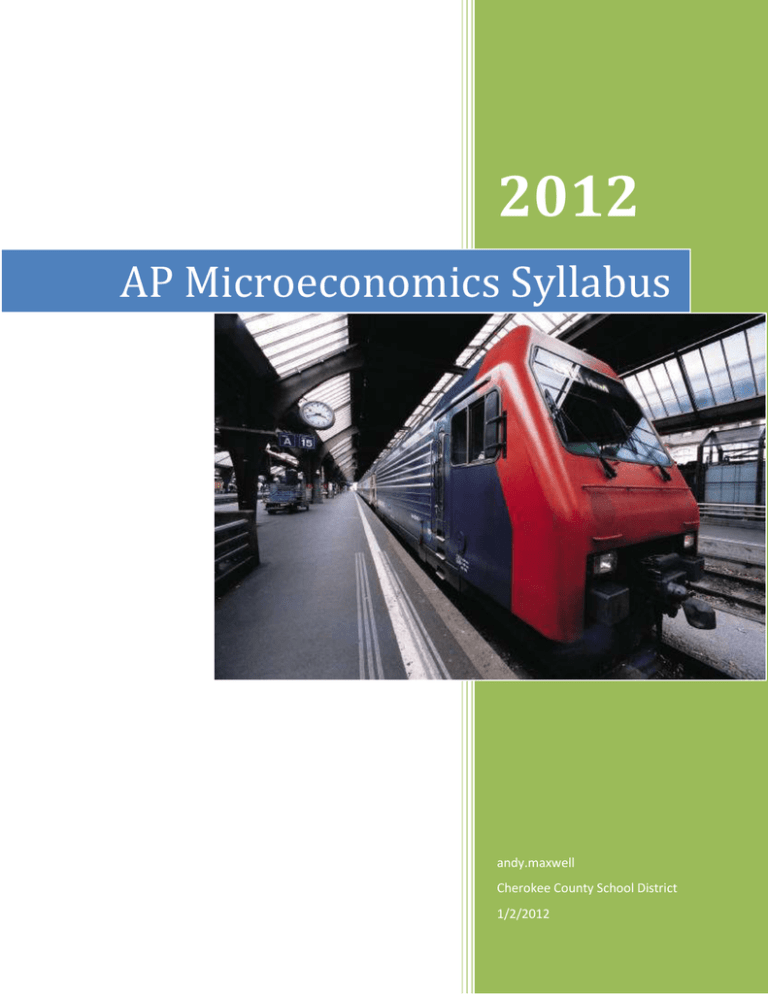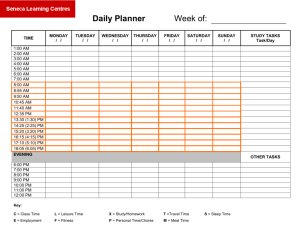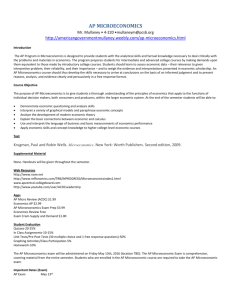AP Microeconomics Syllabus
advertisement

2012 AP Microeconomics Syllabus andy.maxwell Cherokee County School District 1/2/2012 Advanced Placement Microeconomics Syllabus Mr. Andy Maxwell Sequoyah High School Course Description: The purpose of AP Microeconomics is to give students a thorough understanding of the principles of economics that apply to the functions of individual decision makers, both consumers and producers, within the larger economic system. It places primary emphasis on the nature and functions of product markets, and includes the study of factor markets and the role of government in promoting greater efficiency and equity in the economy. It includes the following concepts: scarcity, opportunity costs and production possibilities, specialization and comparative advantage, the functions of any economic system, the nature and functions of product market, supply and demand, models of consumer choice, firm production, costs, revenues, product pricing and outputs, efficiency and government policy, factor markets, efficiency, equity, and the role of government. Course Themes: 1. Basic Economic Concepts (8-14% of AP Exam) 2. The Nature and Functions of product Markets (55-70% of AP Exam) 3. Factor Markets (10-18% of AP Exam) 4. Market Failure and the Role of Government (12-18% of AP Exam) Course Materials: Text: Foundations of Economics AP Edition: Robin Bade and Michael Parkin Supplement: Krugman’s Microeconomics for AP: 2nd edition: Margaret Ray and David Anderson. Morton, John, and Rae Goodman, AP Economics Teacher Resource Manual and Workbook, New York: The National Council on Economic Education Additional Text: The Naked Economist; by Charles Wheeler 23 Things They Don’t Tell You About Capitalism; by Ha-Joon Chang Course Format: Readings. Students will be given a list of reading assignments from the Brue text. Students are to read each assignment on or before the date indicated and be prepared to discuss the contents in class the next day. Readings are to be completed on the date assigned regardless of absence or school cancellation. Students are responsible for all material covered in the readings. Additional Readings. Throughout the course, students will be required to read the listed additional texts. The assignments for reading will be as follows: 23 Things They Don’t Tell You About Capitalism The Naked Economists Students will have essay and short answer questions they will be required to complete for each additional reading assignment. Reading assignments will be posted on my website. Lecture. Lecture will be used when a reading topic needs to be clarified or warrants the inclusion of outside information. Students are expected to be attentive and respectful during lecture. It is imperative that students ask questions if they need help to understand a concept. Class Work. Students will engage in various classroom activities to aid in developing skills necessary for success on the AP Microeconomics Exam. Activities utilized include analysis of graphs, economic concepts, and real world scenario modeling. Class work will consist of both individual, small group, and large group tasks. Class Discussions. Discussion among students on the topics addressed in AP Microeconomics will be frequent and students are expected to be prepared to participate. This preparation will be achieved through carefully reading and analyzing the text and by being present in class as much as possible. Writing. The AP Microeconomics Exam has three writing tasks: one long essay and two shorter essay questions. Students will spend time throughout the course learning how to construct these items. Students will receive training in how these essays are graded by exam readers and will be given opportunities to dissect sample essays, as well as practice writing pieces themselves. During the course, students will compose each style of essay for every unit. Essays will be timed to simulate the A.P. Exam. Quizzes/Tests/Exams. Quiz and test dates will be announced with ample time for preparation. Most tests will cover multiple chapters and will usually consist of multiple choice questions to prepare students for the multiple choice portion of the AP Exam. Unit exams will be in paragraph/ essay form. All students are required to take a midterm and final exam. Students will be given an opportunity to do test corrections before or after school. Course Grading: Tests: Quizzes: Projects/ Writing/ Daily: Mid-term: Final Exam: 40% 20% 10% 15% 15% * Cherokee County will add in the Economics EOCT score with the student’s final class grade. The Economics EOCT will count 15 % of the overall grade. Classroom Expectations: Students will come prepared with text, pencil, blue or black pen, paper, and positive attitude to class daily. Students will use class time wisely and will minimize distractions for peers, teacher, and self. Students will be on time. Tardiness will be counted. If tardy, students will come into the room silently and be seated without distracting others. Students will be responsible for discussing work missed due to absence with the teacher upon return. School board policy states that a student has a time limit within which all makeup work must be completed. The time limit is not to exceed 10 school days from the date of the absence. Realize that absence, excused or unexcused, will result in missing something from class. Be diligent about practicing good attendance habits. Students will comply with all rules laid out in the student handbook, paying special attention to items on dress code, cell phones, and attendance. Late work will not be accepted Parents Signature __________________________________________________ Students Signature _________________________________________________ Course Outline: The following information explains the four major units of study in AP Microeconomics. Along with each unit is the amount of the AP Exam that is devoted to the unit, an estimate of the time we will spend on each unit in class, and a few highlights of what students will study. More detailed expectations will be given with each unit. SEE READING GUIDE FOR DETAILED READING AND HOMEWORK ASSIGNMENTS Unit 1: Basic Economic Concepts 8-14% of Exam Approx. 3 Weeks: January 3rd-20th Topics Include: Scarcity, choice, and opportunity costs Production possibilities curve Comparative advantage, absolute advantage, specialization, and trade Economic systems Property rights and the role of incentives Marginal analysis Unit 2: The Nature and Functions of Product Markets 55-70% of Exam Approx. 9 Weeks: January23rd-March.30th Topics Include: Supply and demand Theory of consumer choice Production and costs Firm behavior and market structure Unit 3: Factor Markets 10-18% of Exam Approx.3 Weeks: -April 9th- 27th Topics Include: Derived factor demand Marginal revenue product Labor market and firms’ hiring labor Market distribution of income Unit 4: Market Failure and the Role of Government 12-18% of Exam Approx. Independent Study of Externalities April 30th-May 7th Macroeconomics prepare for EOCT Public goods Public policy to promote competition Income distribution Contact Information Email: Andy.Maxwell@cherokee.k12.ga.us August 2011 Sunday Monday Tuesday Wednesday introduction Scarcity choice and opportunity cost 7 Thursday Saturday 3 Production possibility curve Quiz 5 6 Economic systems 12 13 18 Test unit 119 20 25 27 8 Comparative advantage and absolute advantage Specialization and trade9 10 14 Property rights and role of incentives 16 17 Marginal analysis 21 Market Equilibrium22 23 Determinants of supply and demand 28 Price and quality controls Elasticity30 Friday Cross price elasticities and supply el31 Quiz26 « August 2011 Sunday Monday Tuesday Wednesday Thursday Friday Saturday 1 quiz2 3 Tax dead weight8 Test unit 2 10 Total utility Utility Individual and 15 Test unit 316 and marginal maximization market Income and utility demand substitution curves14 effects 17 4 5 Labor Day 11 October 2011 » September 2011 18 Consumer surplus, producer surplus market efficiency 19 20 7 21 22 23 Long run Cost costs and minimizing economies of input scale combination Test unit 4 FALL BREAK 25 Production functions Marginal Short and production long run and diminishing returns ePrintableCalendars.com 24 « September 2011 Sunday November 2011 » October 2011 Monday Tuesday Wednesday Thursday 2 Profit Normal profit and Profit maximization 4 Perfect competition behavior of firms and markets in short run and long run 9 10 11 Oligopoly12 16 17 18 Test unit 5 23 24 Marginal revenue product and 30 31 6 Monopoly 25 Friday Quiz7 8 13 Monopolistic competition 15 Derived factor demand Labor market and firms’ hiring of labor 27 Market distribution of income ePrintableCalendars.com Saturday 21 quiz 22 29 Monday Tuesday 6 13 Outside reading Wednesday Thursday Friday Test unit 5 2 8 9 Externalities Election Day Saturday Outside reading 10 4 5 11 12 Positive and negative externalities and remedies Marginal social benefit and cost Public goods vs. Private goods 15 16 17 Test unit 618 19 20 THANSGIVING BREAK 22 23 24 25 26 27 Public policy to promote competition 29 Thanksgiving Day Income distribution Equity and sources of income inequality ePrintableCalendars.com « November 2011 Sunday Monday 4 Tuesday 5 Final Review and Catch up 11 Wednesday 6 EOCT Thursday 1 Friday Test unit 72 7 8 9 10 13 14 15 16 17 23 24 FINALS 19 Saturday 3 EOCT 12 EXAMS 18 January 2012 » December 2011 EXAMS 20 21 22 Christmas Eve 25 26 27 28 Christmas Day 29 30 31 New Year's Eve ePrintableCalendars.com




